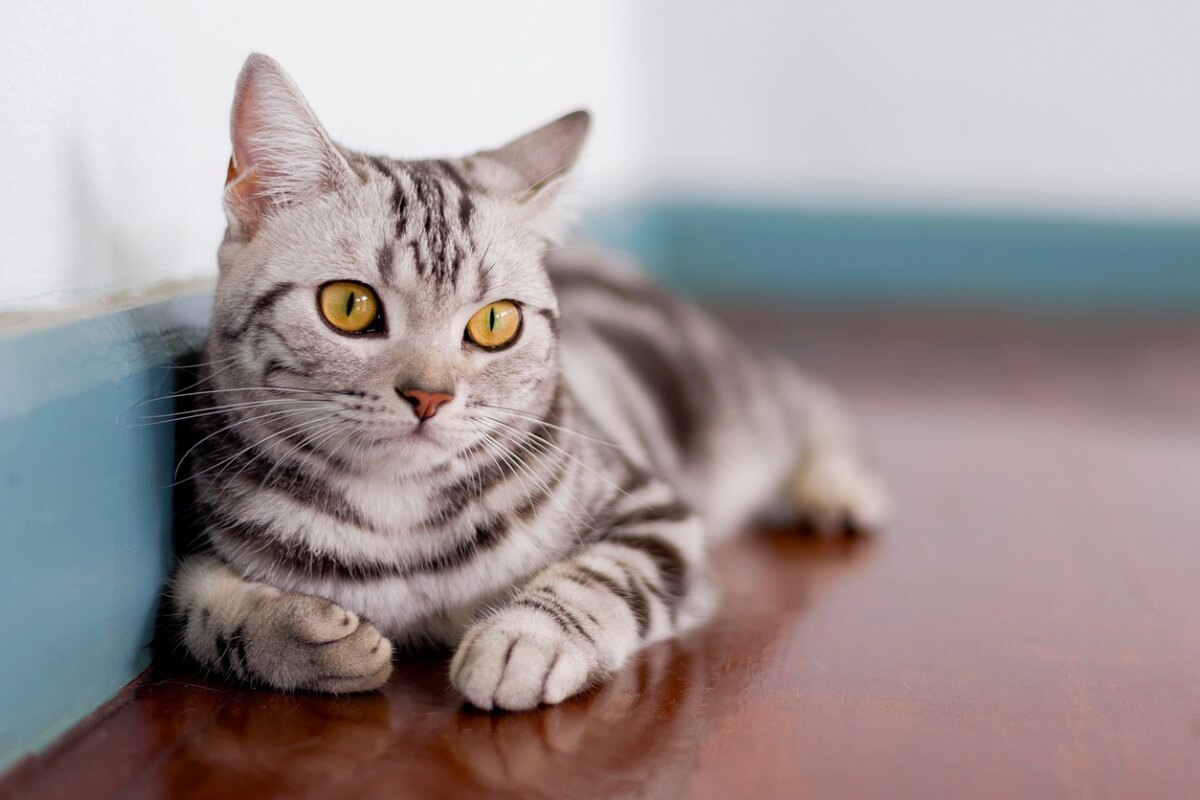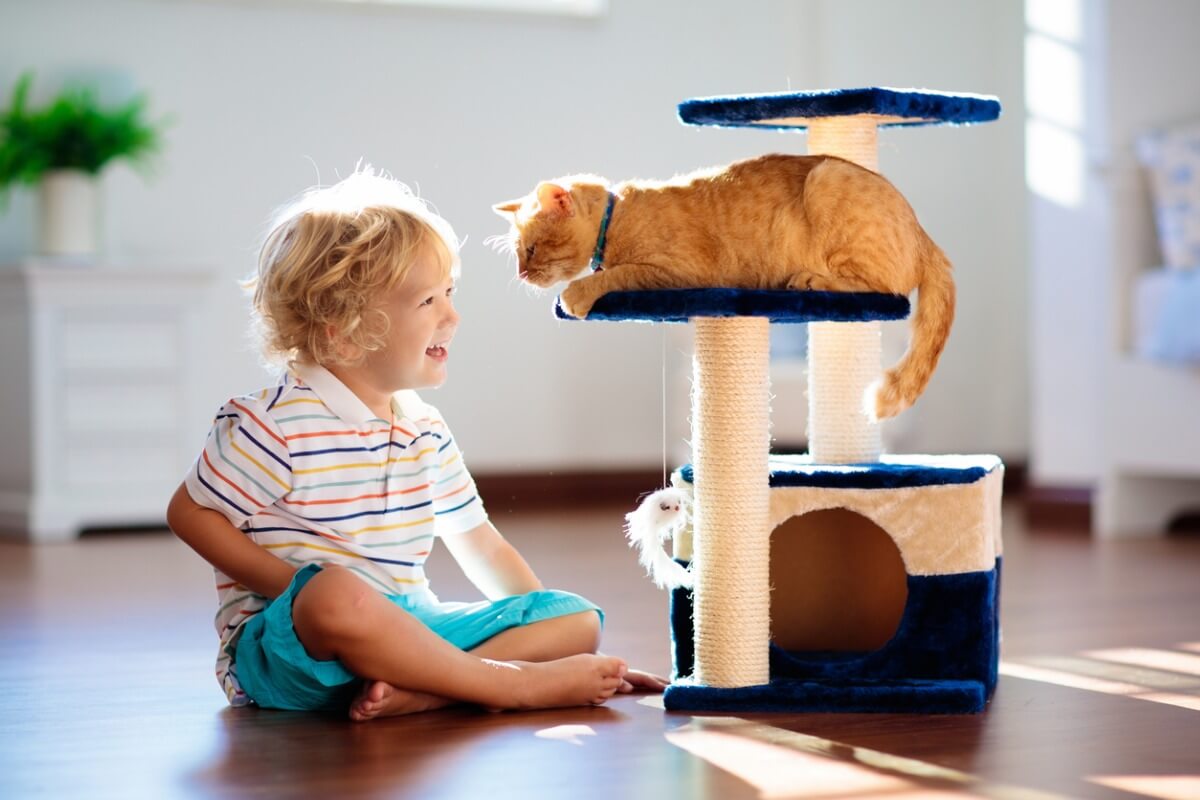Cats Can also Suffer from Separation Anxiety

Separation problems in dogs are a well-studied topic, but there hasn’t been as much research in the feline world. Being well-known as independent and detached animals gives us the feeling that cats don’t suffer from separation anxiety, but this isn’t true.
It’s extremely clear that domestic cats create a bond with their owners, so it isn’t surprising that they can also develop some problems related to attachment. This is exemplified by the separation anxiety in cats, recently studied in depth by a group of scientists. Here we’ll tell you more about it.
What is separation anxiety?
Separation anxiety is the feeling of excessive anguish and worry in the absence of another animal. It can occur in any social species, but is more common in those that have been domesticated, such as cats and dogs.
In the specific case of cats, the felid suffers anxiety every time it’s separated from its owner or another animal it lives with, whether it’s the same species or not. Dogs that tend to spend all day with their human owner and show them intense affection are often more prone to separation anxiety.

How is anxiety manifested in cats?
Recognizing the symptoms of anxiety in cats isn’t only useful to identify the disorder at hand. Its identification can be applied to many other contexts, such as the stress of a move or the uneasiness of entering the home of another animal. Here are the most common signs that your cat could be feeling anxiety:
- Exaggerated and continuous vocalizations: Crying, meowing, and yowling, among others.
- Abnormal stools and vomiting outside the litter box: Rugs, personal objects or sofas are some of the places that felines with this disorder can choose to relieve themselves.
- Destructive behavior: The cat isn’t sharpening its nails on the couch, it’s actually destroying it on purpose. This behavior can also be directed at other furnishings and furniture.
- Excessive grooming: Cats release tension through licking, but when they do it for too long or alopecia appears then it’s cause for concern.
Separation anxiety in cats
In the specific case of the cat-guardian separation, the signs of anxiety are a bit more specific. The behavior described above can occur at two different times:
- When the owner prepares to leave: The cat knows the signals that precede the departure of their owner, such as seeing them get dressed or put on their shoes. At this time, attachment behaviors predominate, such as vocalizations and affectionate gestures.
- When the cat is left alone: At this time, abnormal stools and destructive behavior appear. Excessive vocalizations are also common (although no one can hear them).
A study published in 2020 delved into this question due to the quarantine for the COVID-19 virus, since many pets got used to having their owners permanently at home in this exceptional situation. Taking advantage of this scenario, the attachment and anxiety behaviors of 223 domestic cats were evaluated.
The results were revealing: behavior such as destructiveness, excessive vocalization, and inadequate urination or defecation were found in 13.45% of cats in the absence of their owners. In this group, the signs of separation anxiety were significant.
However, the study was criticized for the fact that tutors could give biased responses in the questionnaire and that an observational validation of the cat’s behavior would be needed.
How to help your cat overcome anxiety?
What to do if you are in this situation? Many owners leave home scared of what they may find when they return, and they suffer due to their cat’s discomfort. If this is still a problem in your case, then here are some tips to help your feline with anxiety:
- Play some soft music before you go. There are sounds created specifically for cats that have proven effective in calming them.
- Try to associate the objects that trigger your cat’s anxiety with positive things. For example, if the feline gets upset when he sees you putting his shoes on, leave them next to a treat or toy.
- Desensitize stressful stimuli. If the cat feels anxious when you pick up the keys, grab and release them several times a day. In this way, they’ll stop associating them with your departure.
- Make false starts. Open and close the door, and go in and out, at random times. This is another desensitization exercise, but it’s best done after working on the signals prior to you leaving.
- Distract him before you go out. Before you go, spread some dry food or treats around the house. This will ensure that the cat is focused on looking for them and doesn’t realize that you have left the house. Intelligence games are also a good option.
- Ask another member of the family to pay special attention to the pet when you leave. In this way, you reduce the feeling of abandonment that your walking generates in the cat. Also, pampering and games will calm your anxiety.
- Spend quality time with your cat. If love and play are present on a day-to-day basis, it’ll be easier for the feline to feel that you’ll always return, due to all the affection you show them.
- Create routines. Following strict times for meals, cleaning or games will help the cat feel that your leaving is part of that routine, as well as your return. Taking away uncertainty from your cat’s life always helps its mental health.

Last (but certainly not least), don’t punish your cat. The changing behavior is due to them missing you. Although it’s a difficult situation to deal with, a reprimand is never going to fix what patience and positive reinforcement can. If you find that you can’t handle the situation on your own, don’t be afraid to consult a professional.
Separation problems in dogs are a well-studied topic, but there hasn’t been as much research in the feline world. Being well-known as independent and detached animals gives us the feeling that cats don’t suffer from separation anxiety, but this isn’t true.
It’s extremely clear that domestic cats create a bond with their owners, so it isn’t surprising that they can also develop some problems related to attachment. This is exemplified by the separation anxiety in cats, recently studied in depth by a group of scientists. Here we’ll tell you more about it.
What is separation anxiety?
Separation anxiety is the feeling of excessive anguish and worry in the absence of another animal. It can occur in any social species, but is more common in those that have been domesticated, such as cats and dogs.
In the specific case of cats, the felid suffers anxiety every time it’s separated from its owner or another animal it lives with, whether it’s the same species or not. Dogs that tend to spend all day with their human owner and show them intense affection are often more prone to separation anxiety.

How is anxiety manifested in cats?
Recognizing the symptoms of anxiety in cats isn’t only useful to identify the disorder at hand. Its identification can be applied to many other contexts, such as the stress of a move or the uneasiness of entering the home of another animal. Here are the most common signs that your cat could be feeling anxiety:
- Exaggerated and continuous vocalizations: Crying, meowing, and yowling, among others.
- Abnormal stools and vomiting outside the litter box: Rugs, personal objects or sofas are some of the places that felines with this disorder can choose to relieve themselves.
- Destructive behavior: The cat isn’t sharpening its nails on the couch, it’s actually destroying it on purpose. This behavior can also be directed at other furnishings and furniture.
- Excessive grooming: Cats release tension through licking, but when they do it for too long or alopecia appears then it’s cause for concern.
Separation anxiety in cats
In the specific case of the cat-guardian separation, the signs of anxiety are a bit more specific. The behavior described above can occur at two different times:
- When the owner prepares to leave: The cat knows the signals that precede the departure of their owner, such as seeing them get dressed or put on their shoes. At this time, attachment behaviors predominate, such as vocalizations and affectionate gestures.
- When the cat is left alone: At this time, abnormal stools and destructive behavior appear. Excessive vocalizations are also common (although no one can hear them).
A study published in 2020 delved into this question due to the quarantine for the COVID-19 virus, since many pets got used to having their owners permanently at home in this exceptional situation. Taking advantage of this scenario, the attachment and anxiety behaviors of 223 domestic cats were evaluated.
The results were revealing: behavior such as destructiveness, excessive vocalization, and inadequate urination or defecation were found in 13.45% of cats in the absence of their owners. In this group, the signs of separation anxiety were significant.
However, the study was criticized for the fact that tutors could give biased responses in the questionnaire and that an observational validation of the cat’s behavior would be needed.
How to help your cat overcome anxiety?
What to do if you are in this situation? Many owners leave home scared of what they may find when they return, and they suffer due to their cat’s discomfort. If this is still a problem in your case, then here are some tips to help your feline with anxiety:
- Play some soft music before you go. There are sounds created specifically for cats that have proven effective in calming them.
- Try to associate the objects that trigger your cat’s anxiety with positive things. For example, if the feline gets upset when he sees you putting his shoes on, leave them next to a treat or toy.
- Desensitize stressful stimuli. If the cat feels anxious when you pick up the keys, grab and release them several times a day. In this way, they’ll stop associating them with your departure.
- Make false starts. Open and close the door, and go in and out, at random times. This is another desensitization exercise, but it’s best done after working on the signals prior to you leaving.
- Distract him before you go out. Before you go, spread some dry food or treats around the house. This will ensure that the cat is focused on looking for them and doesn’t realize that you have left the house. Intelligence games are also a good option.
- Ask another member of the family to pay special attention to the pet when you leave. In this way, you reduce the feeling of abandonment that your walking generates in the cat. Also, pampering and games will calm your anxiety.
- Spend quality time with your cat. If love and play are present on a day-to-day basis, it’ll be easier for the feline to feel that you’ll always return, due to all the affection you show them.
- Create routines. Following strict times for meals, cleaning or games will help the cat feel that your leaving is part of that routine, as well as your return. Taking away uncertainty from your cat’s life always helps its mental health.

Last (but certainly not least), don’t punish your cat. The changing behavior is due to them missing you. Although it’s a difficult situation to deal with, a reprimand is never going to fix what patience and positive reinforcement can. If you find that you can’t handle the situation on your own, don’t be afraid to consult a professional.
All cited sources were thoroughly reviewed by our team to ensure their quality, reliability, currency, and validity. The bibliography of this article was considered reliable and of academic or scientific accuracy.
- de Souza Machado, D., Oliveira, P. M. B., Machado, J. C., Ceballos, M. C., & Sant’Anna, A. C. (2020). Identification of separation-related problems in domestic cats: A questionnaire survey. PloS one, 15(4), e0230999.
- Solis-Moreira, J. Cats Are Calmed by Cat-Specific Music.
- Edwards, C., Heiblum, M., Tejeda, A., & Galindo, F. (2007). Experimental evaluation of attachment behaviors in owned cats. Journal of Veterinary Behavior, 2(4), 119-125.
This text is provided for informational purposes only and does not replace consultation with a professional. If in doubt, consult your specialist.








